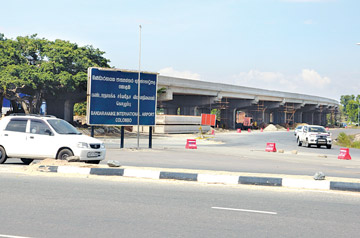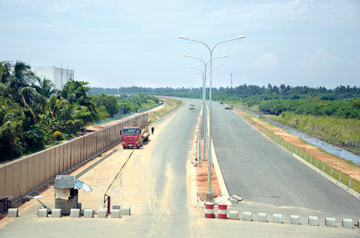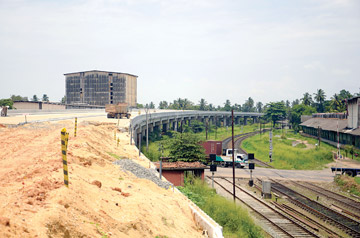Katunayake Expressway, another leap into the future
By Ranil Wijayapala

Bandaranaike Airport junction |

The Expressway at Kerawalapitiya |
With the opening of the Southern Expressway, the country's first
limited access road in November 2011, people gained the experience of
reaching long distances within a short time. Similarly, people who
travel to Katunayake, particularly to the Bandaranaike International
Airport, too desired to reach their destination within a short time.
As the country is moving fast on the track of development, all these
dreams are becoming a reality and the Katunayake Expressway, a long
awaited dream of the people, is also coming true, with speedy
construction work going on between Colombo and Katunayake.
According to Project Director of Colombo Katunayake Expressway Pushpa
Gunaratne, people will soon have the opportunity of hassle-free travel
between Colombo and Katunayake as they have completed more than 80
percent of the construction work of the project, targeting its
completion by August this year.
The project, which basically aims to reduce travel time between
Colombo and Katunayake from one-and-a-half hours during peak hours, to
20 minutes, is now at its final stages of connecting the Expressway to
the other road networks through access roads.
"Generally, with the completion of the Expressway, it will take only
20 minutes to travel from New Kelani Bridge to Katunayake, whereas at
present it takes over one-and-a-half hours", Gunaratne said.
Though the general perception is that the Katunayake Expressway is
purely an easy access route to the Bandaranaike International Airport,
the Expressway is not meant only for those going to the airport and
coming out of it.
"There is a misconception among the public that this expressway is
only for people going to the airport. However this is not only for the
airport. It will cater also to the people using the Negombo - Colombo
Road to reduce travel time when travelling to Negombo, Chilaw or Jaffna",
Gunaratne said.
Four interchanges
Therefore, this 25.8 kilometre limited access road will have four
interchanges for the people to enter and exit from the road. They will
be basically located at New Kelani Bridge, Peliyagoda, Ja-ela and
Katunayake.
"Colombo-bound people from Negombo, Chilaw and Jaffna too can use
this Expressway by entering from the Bandaranaike Airport junction", he
said.
Another interchange will be constructed at Kerawalapitiya, to connect
the Katunayake Expressway with the Outer Circular Road which is now
under construction, in three stages from Kottawa to Kaduwela, Kaduwela
to Kadawatha and Kadawatha to Kerawalapitiya.
Through the Outer Circular Road, the Katunayake Expressway will also
be connected to the Southern Highway in the future and it will become a
road connecting the two international airports in the country in
Katunayake and Mattala, once the Southern Highway is extended upto
Mattala in its third phase.
"With the development of this Expressway and its access roads, the
areas around it will also be developed and become highly commercialised
areas in the future", he said.
According to Gunaratne, the first two kilometres of the Expressway
from the New Kelani Bridge, to Peliyagoda interchange will be
constructed as a six-lane. From there it will be a four-lane road for
the motorists to travel at a speed of 100 kilometres per hour.
 |
| Construction
work in progress |

At Wattala Hunupitiya |
"With the construction of this expressway, we are also creating two
other link roads to the Expressway; one at Peliyagoda to link the
Expressway with the Colombo Kandy Road at Thorana Junction, and also to
link the Expressway with Negombo Road at Wattala", he said.
Therefore, motorists coming from the Kandy Road can enter the
Expressway without reaching the New Kelani Bridge entry/exit point while
the motorists on Negombo Road can enter the Expressway from Wattala.
"As the new fish market in Peliyagoda is also located close to this
link road, this will also provide easy access for its users", he said.
"We can reduce traffic congestion on the New Kelani Bridge as most
people will use the access roads from Peliyagoda and Wattala to enter
the expressway", he said.
The road commencing from the New Kelani Bridge will cross the present
Negombo - Colombo A-3 road at Mabole through a 500 metre viaduct from
Hunupitiya to Mabole.
"So, up to Mabole from Colombo, the Katunayake Expressway will be on
the right side of the Negombo Road and beyond Mabole it will be on the
left", he said.
Embankment fillers
Beyond Mabole the entire road will go through the Muthurajawela
marshland and it has been constructed on embankment fillers after
filling the marshy land with sea sand.
The next interchange at Ja-ela will be located after 16 kilometres
from the Peliyagoda interchange. Anybody from Ja-ela and Gampaha too can
access the road through the Ja-ela interchange.
"There is no change in the distance whether you use the Expressway or
the normal road; the difference will only be in the travel time", he
said.
After crossing the Muthurajawela marshy land, the Expressway will
again cross the Negombo Road at Bandaranaike Airport junction through a
viaduct. However, it does not go right to the airport, but will end
close to the Airport Road, Katunayake.
"We have completed 80 percent of the construction work as of now and
between the eight kilometres and the 20 kilometres we have completed
more than 90 percent of the work", Gunaratne said.
The Outer Circular Road that is being constructed at present will be
connected to the Expressway at Kerawalapitiya.
"Part of the Kerawalapitiya interchange is also now being constructed
under this project so that it will not disturb the smooth operation of
the road when connecting the Outer Circular Road with the Katunayake
Expressway", he said.
A toll system similar to that of the Southern Expressway will also be
introduced for the Katunayake Expressway once it becomes operational.
"There will be a toll system similar to the Southern Highway, but we
have not decided the toll amount yet", he said.
"We will be having our main control room in Seeduwa. From there we
will control the Expressway.
It will have Fire Brigade, Police and toll centre monitoring systems
with a CCTV cameras. The entire road will be covered with CCTV camera
system", he said.
Since the Expressway has been constructed filling the environmentally
sensitive Muthurajawela marshland, drastic measures have also been taken
to mitigate the environmental impact from the project, basically to
mitigate floods.
"To mitigate floods in Muthurajawela, we constructed 42 bridges to
facilitate the smooth flow of water. Another 102 large sized box
culverts were also constructed to facilitate the smooth flow of water in
the marshland", he said.
Apart from this, with the commencement of the project, the canal
system in the area will also be improved.
"We are improving the Dutch Canal along with this project and it will
be widened to 40 metres. This canal is about eight kilometres and at
some areas and sections of this canal cannot be seen as it has been
neglected for a considerable period", he said.
The Muthurajawela terrace was selected for this project since it
avoids the displacement of the public. Only 700 houses had to be shifted
to facilitate this project and they have been compensated at a cost of
Rs.3 billion.
Additional cost
"By doing so we incurred an additional cost. Although the project was
estimated to cost US$ 292 million, it cost US$ 335 million, for
construction purposes alone", he said.
The Exim Bank of China is funding 85 percent of the project and the
balance is borne by the Government.
"Though the construction is done by the China Meteorological Group
Corporation, the local participation at this project is also very high
since they have many local technical people. The supervision is done by
an Australian company called SMEC Company and they also consist of many
local people", Gunaratne said. Speaking further about the economic
benefits from this project, Gunaratne said that reducing the travel time
between Colombo and Katunayake will be the major benefit.
"There are about 30,000 vehicles per day travelling up and down on
this road. Imagine if we can reduce their travel time by one hour; that
will be a good contribution for the economy. The man hours we are losing
per day can be cut down through this project and that time can be used
for other purposes", he said.
"On the other hand, the running cost of vehicles will be reduced
through this project. If you travel between Colombo and Katunayake on
the Negombo Road, you have to stop and restart at every junction and at
colour lights. That wastes lot of fuel. But with the opening of this
road, they can drive without stopping and it will reduce the vehicle's
operative cost", he said.
"The other benefit we are considering is, people will have the
opportunity to live away from the congested Colombo city if they can
reach the Colombo city within 10 to 20 minutes.
"If a person can come to Colombo within 10 to 15 minutes he/she won't
mind residing outside Colombo", he said. "We are hoping to complete this
project by August this year, to make yet another dream project become a
reality in this country", he said. |



